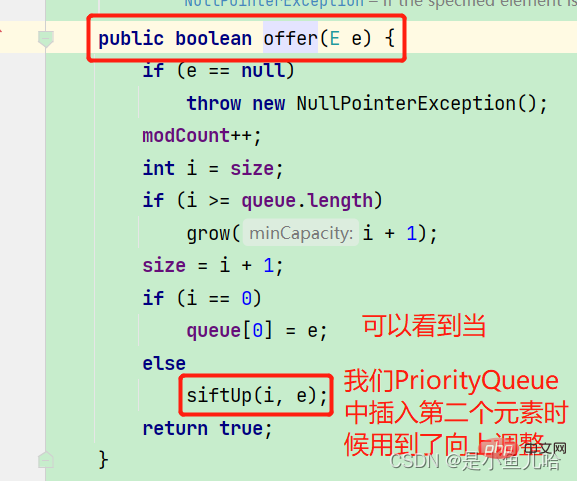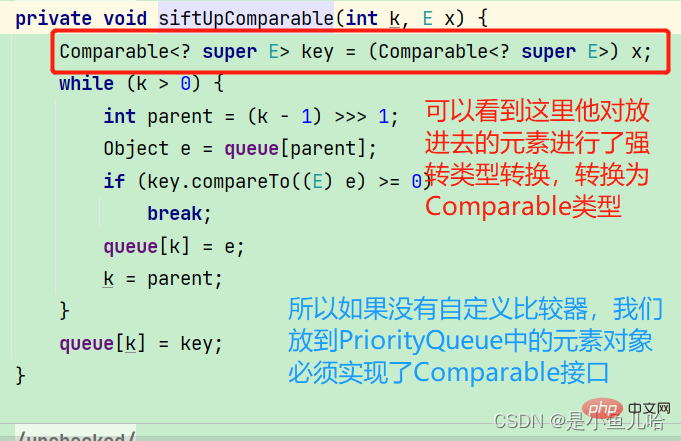PriorityQueue priority queue of Java collection framework
This article brings you relevant knowledge about java, which mainly introduces the relevant knowledge about PriorityQueue priority queue. The Java collection framework provides two types of priorities, PriorityQueue and PriorityBlockingQueue. Level queue, PriorityQueue is thread-unsafe, and PriorityBlockingQueue is thread-safe. Let’s take a look at it together. I hope it will be helpful to everyone.

Recommended study: "java Video Tutorial"
The Java collection framework provides two types of PriorityQueue and PriorityBlockingQueue The priority queue, PriorityQueue is thread-unsafe, and PriorityBlockingQueue is thread-safe. This article mainly introduces PriorityQueue
The relationship of priorityQueue in the Java collection framework is as follows:

1. Points to note when using PriorityQueue
1. When using it, you must import the package where PriorityQueue is located, that is:
import java. util.PriorityQueue
2. The elements placed in the PriorityQueue must be able to be compared in size, and objects that cannot be compared in size cannot be inserted, otherwise
ClassCastException## will be thrown.
time complexity of inserting and deleting elements is log base 2 n
6. The bottom layer of PriorityQueue uses a heap data structure7. PriorityQueue by default It is a small heap---that is, the elements obtained every time are the smallest elements (If we want to turn it into a large heap, we need to re-compare the method. The default comparison method is the compareTo method in the Comparable interface)
2. Introduction to Common Interfaces of PriorityQueue1. Construction of Priority QueueHere are just a few common construction methods inPriorityQueue, for others, you can refer to the help documentation.
| Function introduction | |
| Create an empty Priority queue, | The default capacity is 11 |
| initialCapacity) | Create a initial capacity is initialCapacity Priority queue, Note: initialCapacity cannot be less than 1, otherwise an IllegalArgumentException will be thrown Often |
##PriorityQueue(Comparator comparator) | with default initial capacity and compare its elements against the specified comparator |
PriorityQueue(int initialCapacity, Comparator comparator) | Create a Initial capacity is initialCapacity initialCapacity cannot be less than 1, otherwise IllegalArgumentException will be thrown Often |
| Function Name | Function introduction |
| boolean offer(E e) |
Insert element e, and return true if the insertion is successful, if the e object is empty , throwing NullPointerException, time complexity, note: when the space is not enough, it will be expanded |
| Get the element with the highest priority , if the priority queue is empty, return null | |
| Remove the highest priority element and return, if the priority queue is empty, return null | |
| Get the number of valid elements | |
| clear() | Clear|
| boolean isEmty() | Check whether the priority queue is empty and return if empty true
java video tutorial"
The above is the detailed content of PriorityQueue priority queue of Java collection framework. For more information, please follow other related articles on the PHP Chinese website!

Hot AI Tools

Undresser.AI Undress
AI-powered app for creating realistic nude photos

AI Clothes Remover
Online AI tool for removing clothes from photos.

Undress AI Tool
Undress images for free

Clothoff.io
AI clothes remover

AI Hentai Generator
Generate AI Hentai for free.

Hot Article

Hot Tools

Notepad++7.3.1
Easy-to-use and free code editor

SublimeText3 Chinese version
Chinese version, very easy to use

Zend Studio 13.0.1
Powerful PHP integrated development environment

Dreamweaver CS6
Visual web development tools

SublimeText3 Mac version
God-level code editing software (SublimeText3)

Hot Topics
 1386
1386
 52
52
 Perfect Number in Java
Aug 30, 2024 pm 04:28 PM
Perfect Number in Java
Aug 30, 2024 pm 04:28 PM
Guide to Perfect Number in Java. Here we discuss the Definition, How to check Perfect number in Java?, examples with code implementation.
 Weka in Java
Aug 30, 2024 pm 04:28 PM
Weka in Java
Aug 30, 2024 pm 04:28 PM
Guide to Weka in Java. Here we discuss the Introduction, how to use weka java, the type of platform, and advantages with examples.
 Smith Number in Java
Aug 30, 2024 pm 04:28 PM
Smith Number in Java
Aug 30, 2024 pm 04:28 PM
Guide to Smith Number in Java. Here we discuss the Definition, How to check smith number in Java? example with code implementation.
 Java Spring Interview Questions
Aug 30, 2024 pm 04:29 PM
Java Spring Interview Questions
Aug 30, 2024 pm 04:29 PM
In this article, we have kept the most asked Java Spring Interview Questions with their detailed answers. So that you can crack the interview.
 Break or return from Java 8 stream forEach?
Feb 07, 2025 pm 12:09 PM
Break or return from Java 8 stream forEach?
Feb 07, 2025 pm 12:09 PM
Java 8 introduces the Stream API, providing a powerful and expressive way to process data collections. However, a common question when using Stream is: How to break or return from a forEach operation? Traditional loops allow for early interruption or return, but Stream's forEach method does not directly support this method. This article will explain the reasons and explore alternative methods for implementing premature termination in Stream processing systems. Further reading: Java Stream API improvements Understand Stream forEach The forEach method is a terminal operation that performs one operation on each element in the Stream. Its design intention is
 TimeStamp to Date in Java
Aug 30, 2024 pm 04:28 PM
TimeStamp to Date in Java
Aug 30, 2024 pm 04:28 PM
Guide to TimeStamp to Date in Java. Here we also discuss the introduction and how to convert timestamp to date in java along with examples.
 Java Program to Find the Volume of Capsule
Feb 07, 2025 am 11:37 AM
Java Program to Find the Volume of Capsule
Feb 07, 2025 am 11:37 AM
Capsules are three-dimensional geometric figures, composed of a cylinder and a hemisphere at both ends. The volume of the capsule can be calculated by adding the volume of the cylinder and the volume of the hemisphere at both ends. This tutorial will discuss how to calculate the volume of a given capsule in Java using different methods. Capsule volume formula The formula for capsule volume is as follows: Capsule volume = Cylindrical volume Volume Two hemisphere volume in, r: The radius of the hemisphere. h: The height of the cylinder (excluding the hemisphere). Example 1 enter Radius = 5 units Height = 10 units Output Volume = 1570.8 cubic units explain Calculate volume using formula: Volume = π × r2 × h (4
 How to Run Your First Spring Boot Application in Spring Tool Suite?
Feb 07, 2025 pm 12:11 PM
How to Run Your First Spring Boot Application in Spring Tool Suite?
Feb 07, 2025 pm 12:11 PM
Spring Boot simplifies the creation of robust, scalable, and production-ready Java applications, revolutionizing Java development. Its "convention over configuration" approach, inherent to the Spring ecosystem, minimizes manual setup, allo







 It seems that there is a problem when inserting elements into PriorityQueue
It seems that there is a problem when inserting elements into PriorityQueue 





